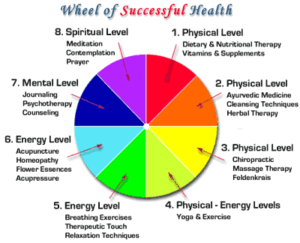
Isn’t it amazing that in this age of scientific and technological advancement people would still believe that the term holistic has to do with witchcraft? I am amazed by the lack of knowledge on holistic health and wellness. There is more to us than an ailing body and confused mind and we must understand the connection in order to be healthy. In this article, I will clarify what holistic health and wellness is and why Holistic Medicine should be the norm.
Holistic Medicine – the practice of treating illness and disease according to every aspect of an individual – mind, body, and soul. The purpose of the treatments and therapies are to restore balance to all systems and thus bring vitality to the individual.
- Uses all forms of healthcare – conventional, complementary, and alternative therapies for the best possible outcome. Providing medications and surgical interventions when alternative therapies and herbal remedies have failed and, of course, in life saving situations.
- Healing takes a partnership or team approach – patient and doctor(s) working together to achieve wellness goals. You know what’s going on with you because you take the time to understand your body and understand what the test results say, all while intelligently conversing with your doctor about your symptoms and actions.
- Patients take responsibility for their health – patient involvement in treatments and lifestyle modifications provides for personal well-being and long-term success. No one can fix your health for you; pills and surgeries are often temporary solutions. If you want to feel good and be healthy you must do the things that are healthy.
- Understands that every person has their own, innate, healing powers – practitioners work to educate individuals on their innate abilities, how to tap in to them, and how to utilize them for complete wellness.
- Addresses all aspects of an individual’s life – social, spiritual, emotional, mental, and physical for the best possible lifestyle modification. Mental illness affects physical health as much as physical illness affects mental health. We are complete beings not separate systems.
- All treatments are done for the purpose of fixing the cause of the disease – whether it be mental, physical, spiritual, or emotional – not just for alleviating symptoms. Holistic medicine looks to reverse disease by changing the individual’s cause of it; everyone is different. One person will smoke and die of cancer, another will smoke the same amount and will die of old age. Our practitioners must consider us this way or many treatments will fail.
- Holistic physicians encourage patients to evoke the healing power of love, hope, humor and enthusiasm, and to release the toxic consequences of hostility, shame, greed, depression, and prolonged fear, anger, and grief.
- Unconditional love is life’s most powerful medicine. Physicians strive to adopt an attitude of unconditional love for patients, themselves, and other practitioners.
- Optimal health is much more than the absence of sickness. It is the conscious pursuit of the highest qualities of the physical, environmental, mental, emotional, spiritual, and social aspects of the human experience.

Holistic Health: a system of preventive care that takes into account the whole individual, one’s own responsibility for one’s well-being, and the total influences—social, psychological, environmental—that affect health, including nutrition, exercise, and mental relaxation.
- Concept that concern for health requires perception of the individual as an integrated system instead of one or more separate parts.
- A health attitude that an individual’s mental state and life experiences form the basis for his or her state of overall health.
- Your overall state of wellness on all levels of your being: physical, emotional, mental and spiritual. It encompasses the health of your entire being and extends to everyone and everything that affects you in any way. That includes your resources, your environment, and your relationships.
- World Health Organization (WHO) defines health as a state of complete physical, mental, and social well-being, not merely an absence of disease or infirmity.
- Health and well-being as a continuum. What you think, how and when you eat, sleep, exercise and relate to others moves you either further on the continuum toward good health or away from it.
So, as you see, by implementing a holistic mindset in your life and in your health care you can obtain optimal health and wellness with minimal discomfort or cost. By taking steps to be in control of your health and in charge of your life you become empowered to live to the fullest. No, it’s not easy, but it’s so worth it!

